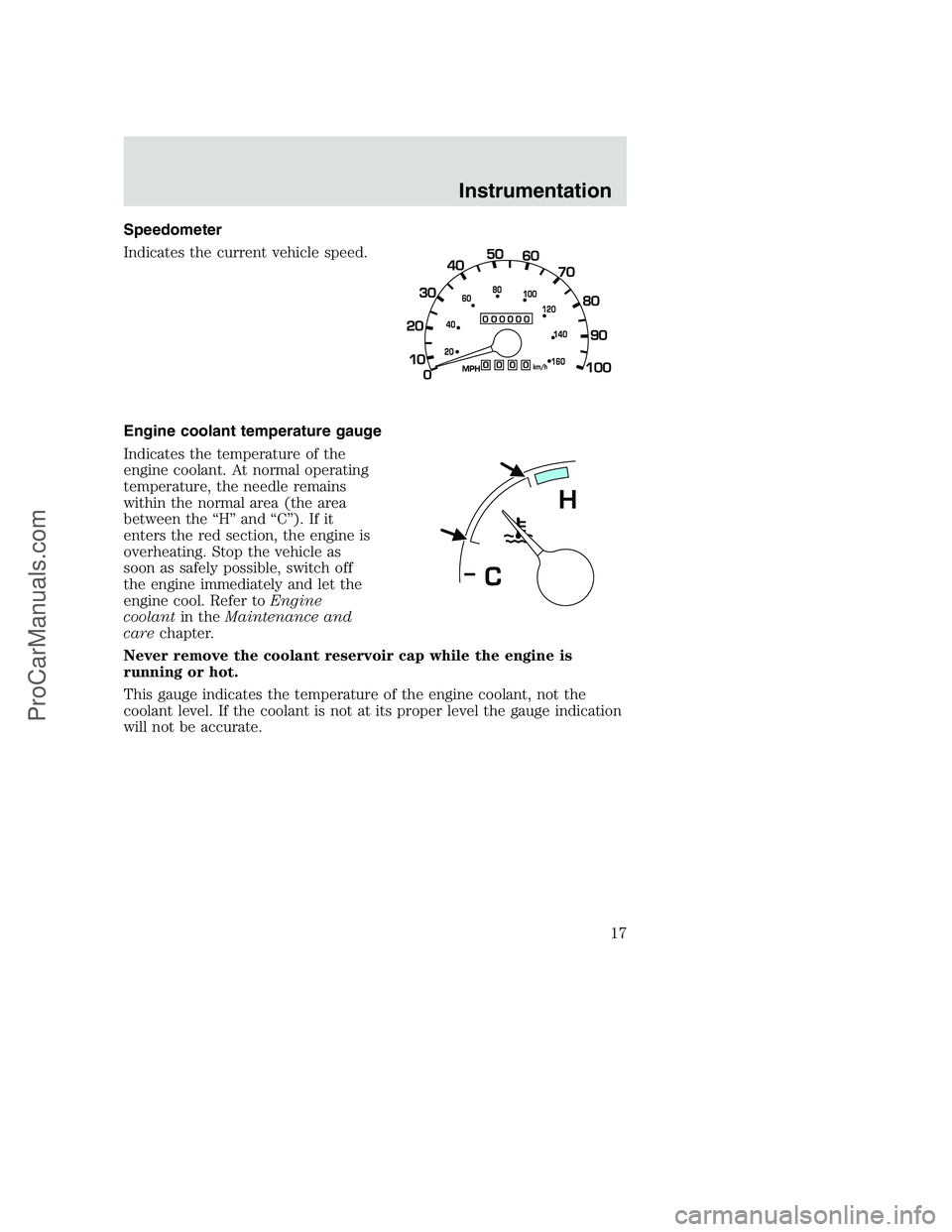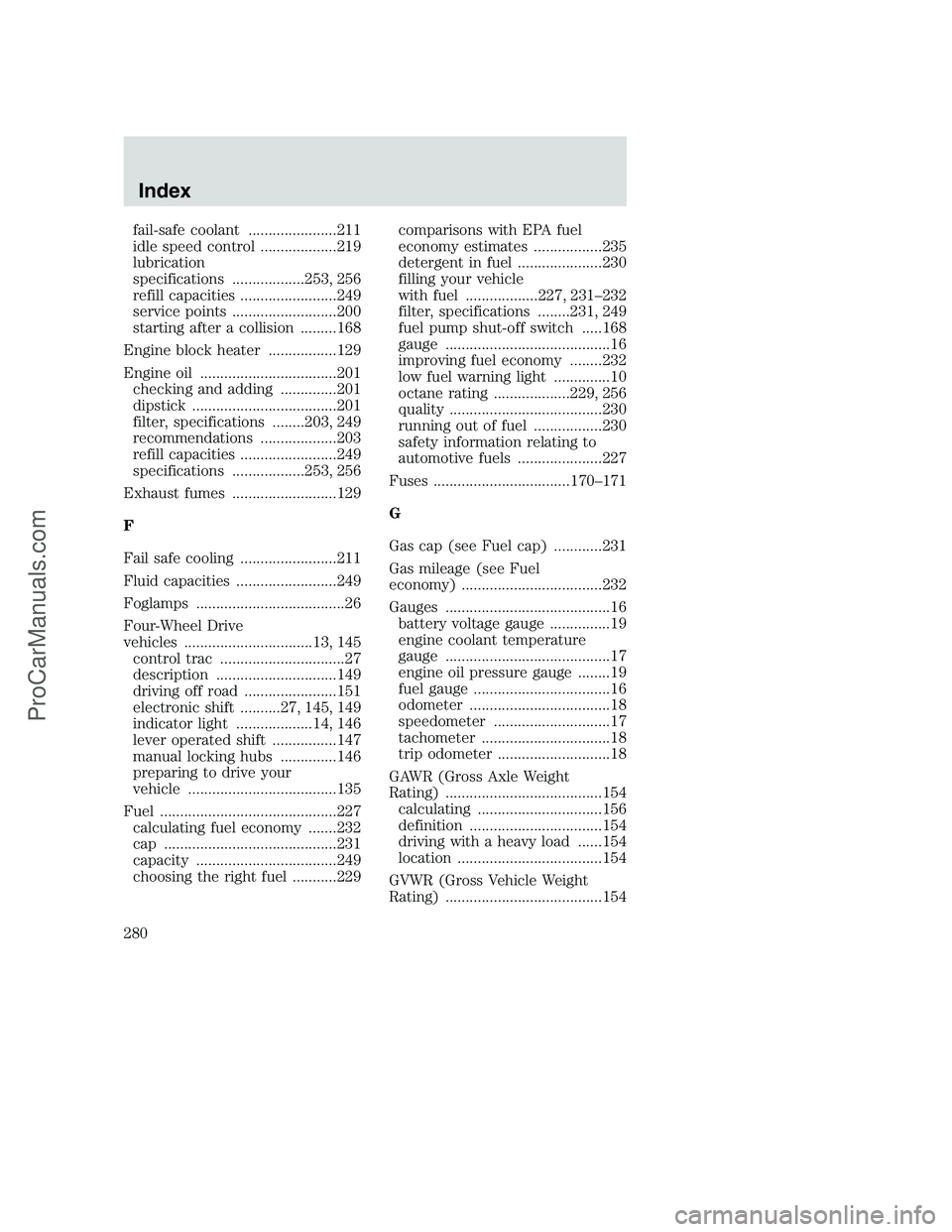2001 FORD F350 coolant temperature
[x] Cancel search: coolant temperaturePage 7 of 288

Vehicle Symbol Glossary
Child Safety Door
Lock/Unlock
Interior Luggage
Compartment Release
Symbol
Panic AlarmEngine Oil
Engine CoolantEngine Coolant
Temperature
Do Not Open When HotBattery
Avoid Smoking, Flames,
or SparksBattery Acid
Explosive GasFan Warning
Power Steering FluidMaintain Correct Fluid
LevelMAX
MIN
Emission SystemEngine Air Filter
Passenger Compartment
Air FilterJack
Check fuel cap
Introduction
7
ProCarManuals.com
Page 14 of 288

Four wheel drive indicator (if equipped)
Momentarily illuminates after the
engine is STARTED. Illuminates
when 4x4 range is engaged. If the
light continues to flash have the system serviced.
Door ajar
Illuminates when the ignition is in
the ON position and any door is
open. It may also momentarily
illuminate after the engine is started
and all doors are closed.
Oil pressure/Engine coolant
This light will illuminate when the
ignition is in the ON position and
the:
•engine coolant temperature is
very high
•engine oil pressure is low
•engine is off
The light serves as a notice that a system needs your attention and to
check the engine coolant temperature gauge and the engine oil pressure
gauge.
Refer toEngine coolant temperature gaugeandEngine oil pressure
gaugein this chapter for more information.
Speed control
This light comes on when either the
COAST/SET or RES/ACCEL controls
are pressed. It turns off when the
speed control OFF control is pressed, the brake is applied or the ignition
is turned to the OFF position.
Safety belt warning chime
Sounds to remind you to fasten your safety belts.
For information on the safety belt warning chime, refer to theSeating
and safety restraintschapter.
4x4
DOOR
AJAR
CRUISE
Instrumentation
14
ProCarManuals.com
Page 17 of 288

Speedometer
Indicates the current vehicle speed.
Engine coolant temperature gauge
Indicates the temperature of the
engine coolant. At normal operating
temperature, the needle remains
within the normal area (the area
between the “H” and “C”). If it
enters the red section, the engine is
overheating. Stop the vehicle as
soon as safely possible, switch off
the engine immediately and let the
engine cool. Refer toEngine
coolantin theMaintenance and
carechapter.
Never remove the coolant reservoir cap while the engine is
running or hot.
This gauge indicates the temperature of the engine coolant, not the
coolant level. If the coolant is not at its proper level the gauge indication
will not be accurate.
H
C
Instrumentation
17
ProCarManuals.com
Page 129 of 288

Using the engine block heater (if equipped)
An engine block heater warms the
engine coolant, which improves
starting, warms up the engine faster
and allows the heater-defroster
system to respond quickly. Use of an
engine block heater is strongly
recommended if you live in a region
where temperatures reach -23°C
(-10°F) or below.
For best results, plug the heater in
at least three hours before starting the vehicle. Using the heater for
longer than three hours will not harm the engine, so the heater can be
plugged in the night before starting the vehicle.
To prevent electrical shock, do not use your heater with
ungrounded electrical systems or two-pronged (cheater)
adapters.
Guarding against exhaust fumes
Although odorless and colorless, carbon monoxide is present in exhaust
fumes. Take precautions to avoid its dangerous effects.
If you ever smell exhaust fumes of any kind inside your vehicle,
have your dealer inspect and fix your vehicle immediately. Do
not drive if you smell exhaust fumes. These fumes are harmful and
could kill you.
Have the exhaust and body ventilation systems checked whenever:
•the vehicle is raised for service
•the sound of the exhaust system changes
•the vehicle has been damaged in a collision
Starting
129
ProCarManuals.com
Page 211 of 288

Refer to the chart on the coolant container to ensure the coolant
concentration in your vehicle will provide adequate freeze protection.
Never increase the engine coolant concentration above 60%
(protection to –60°F). At a level over 60%, your engine could overheat
and become damaged.
If you drive in extremely hot climates, it is still necessary to maintain the
coolant concentration at 50/50 coolant and water.Do not allow the
coolant concentration to fall below 40% coolant.At a concentration
less than 40%, the corrosion protection to your engine and cooling
components may be compromised and permanent damage may result.
What you should know about fail-safe cooling (if equipped)
If the engine coolant supply is depleted, this feature allows the vehicle to
be driven temporarily before incremental component damage is incurred.
The “fail-safe” distance depends on ambient temperatures, vehicle load
and terrain.
How fail-safe cooling works
If the engine begins to overheat:
•The engine coolant temperature
gauge will move to the red (hot)
area.
•The
andsymbol will
illuminate.
•TheService Engine Soon
indicator light will illuminate.
If the engine reaches a preset over-temperature condition, the engine
will automatically switch to alternating cylinder operation. Each disabled
cylinder acts as an air pump and cools the engine.
When this occurs the vehicle will still operate. However:
•The engine power will be limited.
•The air conditioning system will be disabled.
Continued operation will increase the engine temperature and the engine
will completely shut down, causing steering and braking effort to
increase.
Once the engine temperature cools, the engine can be re-started. Take
your vehicle to a service facility as soon as possible to minimize engine
damage.
H
C
Maintenance and care
211
ProCarManuals.com
Page 280 of 288

fail-safe coolant ......................211
idle speed control ...................219
lubrication
specifications ..................253, 256
refill capacities ........................249
service points ..........................200
starting after a collision .........168
Engine block heater .................129
Engine oil ..................................201
checking and adding ..............201
dipstick ....................................201
filter, specifications ........203, 249
recommendations ...................203
refill capacities ........................249
specifications ..................253, 256
Exhaust fumes ..........................129
F
Fail safe cooling ........................211
Fluid capacities .........................249
Foglamps .....................................26
Four-Wheel Drive
vehicles ................................13, 145
control trac ...............................27
description ..............................149
driving off road .......................151
electronic shift ..........27, 145, 149
indicator light ...................14, 146
lever operated shift ................147
manual locking hubs ..............146
preparing to drive your
vehicle .....................................135
Fuel ............................................227
calculating fuel economy .......232
cap ...........................................231
capacity ...................................249
choosing the right fuel ...........229comparisons with EPA fuel
economy estimates .................235
detergent in fuel .....................230
filling your vehicle
with fuel ..................227, 231–232
filter, specifications ........231, 249
fuel pump shut-off switch .....168
gauge .........................................16
improving fuel economy ........232
low fuel warning light ..............10
octane rating ...................229, 256
quality ......................................230
running out of fuel .................230
safety information relating to
automotive fuels .....................227
Fuses ..................................170–171
G
Gas cap (see Fuel cap) ............231
Gas mileage (see Fuel
economy) ...................................232
Gauges .........................................16
battery voltage gauge ...............19
engine coolant temperature
gauge .........................................17
engine oil pressure gauge ........19
fuel gauge ..................................16
odometer ...................................18
speedometer .............................17
tachometer ................................18
trip odometer ............................18
GAWR (Gross Axle Weight
Rating) .......................................154
calculating ...............................156
definition .................................154
driving with a heavy load ......154
location ....................................154
GVWR (Gross Vehicle Weight
Rating) .......................................154
Index
280
ProCarManuals.com